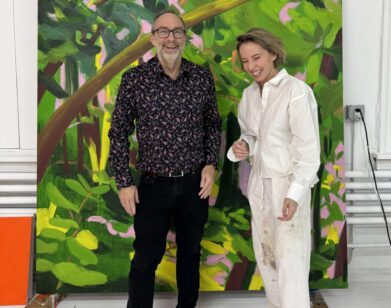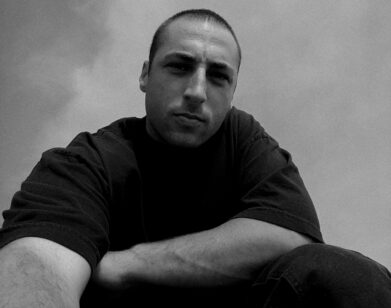Isa Genzken, The Artist Who Doesn’t Do Interviews
Berlin artist Isa Genzken has shattered countless glass ceilings throughout her four-decade career, while inextricably transforming her audiences by mirroring them in the shards. Defying the boys’ club of Germany’s postwar art hotbed in the ’70s and ’80s, she went against the proverbial grain carved out by icons Joseph Beuys, Sigmund Polke, Gerhard Richter, and Bernd Becher to define herself. As one of only five female artists to whom MoMA granted a solo exhibition over the last decade, her latest “Isa Genzken: Retrospective” brought her to the cutting edge of New York’s male-dominated art scene. With an oeuvre spanning an astonishing multiplicity of approaches from assemblage to sculpture to painting to photography to large-scale installations, Genzken simply can’t be defined by a single medium.
Not one to function within the confines of art-world niceties, Isa Genzken once conducted a minute-long video interview with Kai Althoff titled “Why I Don’t Do Interviews.” Notorious for giving precious few throughout her career, we were fortunate enough to pin her down in a blunt and unmistakably Genzken-esque interview on why she doesn’t play the media game, her love affair with New York City, and how former husband Gerhard Richter said her art is better than Andy Warhol’s.
EMILY WASIK: Firstly, congratulations on your traveling “Isa Genzken: Retrospective” exhibition currently on show at MCA Chicago, and thanks for agreeing to do this interview! I can imagine it must be frustrating constantly having to translate your art into words for people, instead of simply letting it speak for itself. Why aren’t you fond of jumping on the press bandwagon?
ISA GENZKEN: Well, I knew I was an artist the moment I woke up in my mother’s belly and, as an artist, I shouldn’t have to give interviews.
WASIK: I read that one of the reasons you got along really well with artists like Joseph Beuys, Dan Graham, and Lawrence Weiner is that you never needed to say much in one another’s presence. You could just simply understand each other without many words needing to be spoken. Do you believe the same relationship should apply between people and art?
GENZKEN: Yes, because in some parts of the world, you get scrutinized for saying the wrong thing about art and in other regions, you get scrutinized for saying nothing at all.
WASIK: You met the charming Mr. Beuys a few times when he was alive. Is it true that he once kissed your hand and said, “You are my teacher”?
GENZKEN: Yes! One time I even said to him, “Architecture is a catastrophe in Germany; we’ve got to change that,” and he told me, “Go ahead, you can always sign for me if you ever need to.” I’ve never taken him up on the offer, though!
WASIK: You once said in an interview, “I want to animate the viewers, hold a mirror up to them.” Why do you believe it’s important to put yourself in the viewer’s shoes and create art that transforms them?
GENZKEN: Because it’s exactly this kind of role reversal that I’m interested in, and then it actually makes it a challenge for the viewer. Also, because most artists work in a completely different way.
WASIK: You once said, “I think my work is very difficult to understand. Sometimes people do and sometimes they don’t. I can’t do much about that.” Why do you think your art is difficult to understand?
GENZKEN: Because “hip-hop” art is simpler and more comprehensible for most people.
WASIK: In one of the portraits of yourself at the MoMA exhibition, you are gazing at a photograph of Andy Warhol. Is he an influence of yours?
GENZKEN: As a matter of fact, when I showed my “HiFi-Series” to Gerhard Richter in the early ’80s, he bought it and said, “This is better than Andy Warhol.”
WASIK: On that note, which artists have inspired or influenced you the most?
GENZKEN: The artists who have disappointed me the least.
WASIK: The German art world in which you came of age was predominantly male. Did you feel that it was important for you to swim against the tide, so to speak, against artists like Beuys and Richter, to distinguish yourself?
GENZKEN: To tell you the truth, it was even more important for me to distinguish myself as being worlds apart from German painter and sculptor Markus Lüpertz.
WASIK: You were married for a decade to Gerhard Richter. Did you influence each other artistically?
GENZKEN: Yes, throughout our marriage, we influenced each other mutually. We didn’t have a student-teacher kind of relationship.
WASIK: Being born in 1948, you grew up in Germany’s post-war boom of the ’50s. How did your upbringing in this postwar landscape influence your art?
GENZKEN: Growing up, my family lived in the richest part of Hamburg and were constantly surrounded by wealth. However, we were not wealthy ourselves and only had one room and a record player.
WASIK: You’ve spoken of your fervent love of New York City, your second home, which has been like a muse of a city for you since you began visiting regularly in the ’70s. You even titled your 2006 book I Love New York, Crazy City. Why the love affair with New York?
GENZKEN: I first went to New York when I was 15. I realized then that it was my city, and it’s stayed that way since.
WASIK: You were in New York when September 11 occurred. Do you remember where you were when it happened?
GENZKEN: I was at the Hilton Hotel and saw the catastrophe on the TV screens in the elevator. I thought it was a new film by Steven Spielberg.
WASIK: Since 1997, you’ve been based in Berlin, which has a completely contrasting visual aesthetic to New York. How do you find the creative atmosphere of Berlin in comparison to New York, with Berlin being a city drenched to the bone in catastrophic history, and also, a city, which, unlike New York, isn’t stereotypically beautiful on the surface?
GENZKEN: For me personally, the greatest art to date has been created in New York and the most uptight and conventional art in Berlin. Obviously, I am an exception to this rule!
WASIK: You seem to have experienced the true “golden eras” of the cities you have lived in. You experienced New York in the ’70s and Berlin in the ’90s, eras that people refer to when they say, “New York/Berlin isn’t what it used to be!” Did these cities really live up to their “art nirvana” hype during these decades?
GENZKEN: Considering that Beuys was born in a small German town called Kleve and I was born in another small German town called Bad Oldesloe, I believe that even an airport can be an inspiring place for an artist. A Nobel Prize laureate once said something along the lines of, “The more one travels, the more intelligent one becomes,” however, I think that you can still travel a lot and remain sheltered.
WASIK: You’re a master of self-reinvention, having used an astonishing variety of techniques throughout your 40-year career from assemblage to sculpture to painting to photography to collage to film to large-scale installations. You keep viewers on the edge of their seats wondering what turn you will take next! Can you give us a hint of what we might expect to see from you in the future?
GENZKEN: Personally, I don’t believe in having expectations, but I can say that, regarding my exterior sculptures, I will only exhibit sculptures in the future that will enrich their surroundings.
WASIK: In recent years, a new generation of artists and art lovers have been inspired by your unconventional ingenuity. What message do you have for the younger generation of up-and-coming artists today? Any words of wisdom?
GENZKEN: Artists should not look to the left or the right. Art should be strong and nonconformist—and most importantly, art should always be personal.
“ISA GENZKEN: RETROSPECTIVE” IS CURRENTLY ON DISPLAY AT THE MUSEUM OF CONTEMPORARY ART (MCA) CHICAGO THROUGH AUGUST 3 AND WILL TRAVEL TO THE DALLAS MUSEUM OF ART (DMA) FROM SEPTEMBER 14 THROUGH JANURARY 4, 2015. FOR MORE DETAILS, VISIT THE MCA CHICAGO OR DMA WEBSITES.







